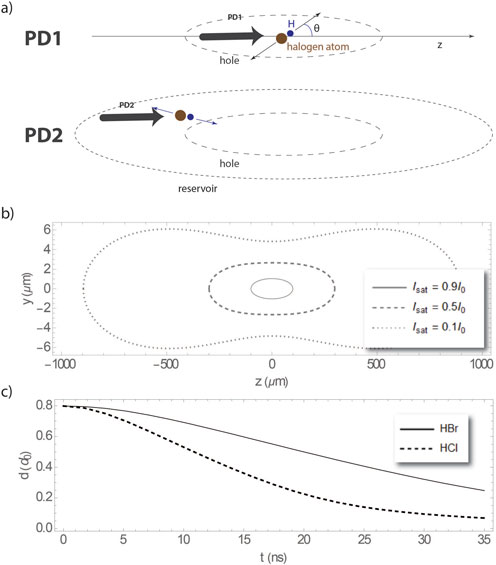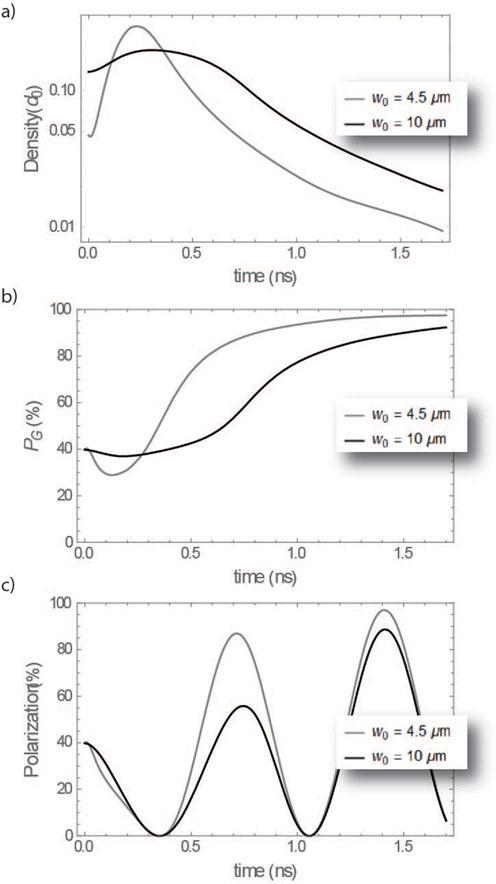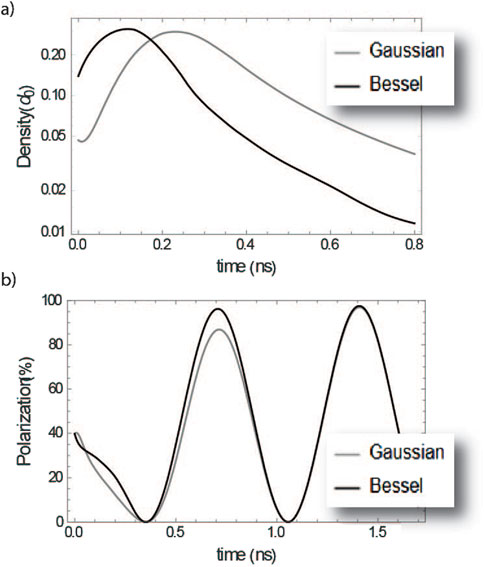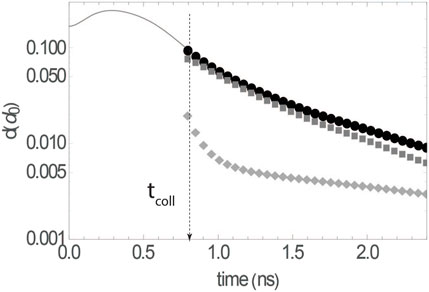- 1Department of Physics, Atomic and Molecular Physics Laboratory, University of Ioannina, Ioannina, Greece
- 2Department of Mathematics, University of Ioannina, Ioannina, Greece
- 3Institute of Electronic Structure and Lasers, Foundation for Research and Technology-Hellas, Heraklion, Crete, Greece
- 4Materials Science and Engineering Department, University of Crete, Heraklion, Greece
- 5Department of Physics, University of Crete, Heraklion, Crete, Greece
High density Spin Polarized Hydrogen (SPH) atoms, which can be prepared using UV dissociation of hydro-halide molecules, can be attractive as potential targets for laser ionization/acceleration schemes aiming to create high energy and high current polarized electron beams. However, for these SPH targets to be of practical use, they have to be spatially isolated from the halide atoms which accompany hydrogen in the parent hydro-halide molecule. We show how the UV dissociation dynamics of hydro-halides and the dissociation geometry and timing can be combined to prepare a variety of isolated SPH targets aimed to accommodate laser acceleration schemes.
1 Introduction
The preparation of high-energy and high-brightness polarized electron beams can offer advantages to various scientific fields, and in particular to high-energy and nuclear physics [1–3]. Among the various preparation methods, laser acceleration of pre-polarized targets, and in particular Spin-Polarized Hydrogen (SPH) atoms, is an attractive option. However, this method requires targets with densities in excess of
Conventional methods for preparing gas-phase SPH atoms are the Stern-Gerlach spin separation of an H-atom beam [4], and spin-exchange optical pumping [5], however these methods are limited to SPH densities of about
Spin polarization in an atomic system results from the orientation of valence electrons, since any electrons participating into closed shells have zero total spin and cannot be polarized. Thus, heavy atoms, with most electrons in closed shells, are not appropriate as pre-polarized targets as the large intensities required for sufficient acceleration will inevitably lead to the ionization of most (if not all) of the unpolarized closed-shell electrons, thus reducing the overall polarization of the resulting electron beam. In contrast, SPH atoms are ideal as prepolarized targets, as SPH atoms have only one (polarized) electron.
However, the photodissociation of hydrogen halides produces SPH and halide atoms, in equal quantity, and the halide atoms provide unwanted unpolarized core electrons. Therefore, special care has to be given to spatially isolating the SPH from the halide atoms. The aim of this paper is to show that this can be achieved by choosing the timing and the geometric characteristics of two consecutive dissociation pulses. Moreover, we show how this spatial isolation can lead to further polarization selection that produces spin polarization values which are much greater than the free-space values.
We present the modeling of the SPH isolation method in Section 2, and in Section 3 we investigate the preparation of two targets. Since the overall electron polarization is controlled by the hyperfine interaction, we choose to investigating the preparation of spin polarized targets with a diameter of 4.5
2 Model
2.1 Dissociation fundamentals
The UV dissociation with circularly polarized light of some common hydro-halide molecules HX, such as HCl and HBr, follows the reaction:
with
with
In Figure 1A we show the speeds and angles associated with UV dissociation and how these can be used to create isolated SPH samples. A first Dissociation Pulse (PD1) dissociates molecules in the vicinity of its focus. The velocity acquired by the fragments leads to them exiting the volume around the focus, hereby referred to as “hole”. A second Dissociation Pulse (PD2), with larger dimensions, dissociates molecules in a volume around the hole, hereby referred to as “reservoir”. The large difference between the Hydrogen and the Halogen atom speeds means that there are times in which only H atoms will have filled the hole volume. Using circularly polarized light for PD2 and well selected dimensions for the hole and reservoir allows the accumulation of highly-polarized, high density SPH atoms in the volume of the hole.

Figure 1. (A) Sequence of UV pulses PD1 (up) and PD2 (down) to create the “hole” and “reservoir”. (B) Limits of Gaussian beams when
2.2 Emptying the hole
Creating a hole devoid of atoms inside a gas-phase sample after dissociation is only viable if the (random) thermal velocities of the parent molecules are small compared to the recoil velocities of the molecular photofragments produced in the hole. In a molecular beam, the molecules can move with speeds of hundreds of meters per second, however, their thermal motion in the molecular rest frame can be cooled down to the 0.1–10 K range [17, 18]. For example, the average thermal speed of HCl molecules at 3 K (46 m/s) is much smaller than the recoil speeds of the H and Cl photofragments from photodissociation at 213 nm.
We now consider the geometry of the focused laser pulses, needed to create the hole and reservoir. The intensity distribution of a laser pulse follows Gaussian optics:
with
When illuminating a molecular beam with UV laser light, molecular photodissociation can be initiated with a probability which depends on
A realistic geometry should include gradual descending borders, since the probability for dissociation is non-zero for intensities lower, yet close to
with
If we choose a single recoil direction, characterized by
with
The total density inside the hole, as a function of time will be:
with
2.3 Reloading isolation and polarization
The hole can be reloaded by illuminating a larger volume using a second laser pulse. We can define a “reservoir” function
The density of the hydrogen atoms entering the hole as a function of time, for a given recoil direction is (step 2: reloading the hole):
with
The polarization of the hydrogen atoms depends on both their recoil direction and the time after dissociation. The temporal dependence results from the hyperfine interaction [7]:
with
where
Numerically, the polarization inside the hole will be given by the similar formula:
In Figure 2A, we see the evolution of

Figure 2. (A) Evolution of
The brown and green points are values obtained for different choices for
The situation is similar in the case of an oblate ellipsoidal geometry shown in Figure 2C. The light green ellipse is a slice of the hole and the dashed dark green ellipse a slice of the reservoir, in the xz plane. Here, the first atoms leaving the hole are moving in the z direction. Thus, at later times, a similar integration angle can be found as a function of time, however, now it will be the angle
3 Results
3.1 Isolation density and polarization
We apply this model for some characteristic geometries for the dissociation pulses. We will compare holes created using a

Figure 3. (A) Density inside the hole as a function of time after firing PD2 for
4 Discussion
The exact shape of the UV dissociation pulses, beyond just the spotsize, can impact these dynamics, allowing for faster loading and polarization in some circumstances. To demonstrate this, we will compare the results obtained using a Gaussian pulse with

Figure 4. (A) Photodissociation probability and pulse intensity along the x/y direction, for a shaped and a Gaussian pulse. (B) Photodissociation probability and pulse intensity along the z direction, for a shaped and a Gaussian pulse.
In Figure 5 we present the results obtained using a Gaussian and a top-hat pulse such as the ones shown in Figure 4. We see that the dynamics are accelerated when a top-hat pulse is used, both in density shown Figure 5A and total polarization shown in Figure 5B. However, we see that, as far as total polarization is considered, while in the first hyperfine oscillation period the improvement is important (close to 10%) it is negligible at later times.

Figure 5. (A) Density inside the hole as a function of time after firing PD2, for a shaped and a Gaussian pulse and (B) total polarization.
We demonstrated here that it is possible to isolate SPH atoms, in high polarization and density, for a variety of geometries. Different sizes for the isolated sample, of course, affect the dynamics and ultimately the time on which a highly polarized sample can be prepared. On the one hand, large size targets will increase the overall charge in the polarized electron beam created after laser ionization/acceleration of such a sample. On the other hand, larger samples require longer preparation times, which might become comparable to the mean free time for collisions. It is clear that our model does not take into account collisions, and while depolarization collisions are only important in higher densities [20], close to
Let’s consider the effect of elastic non-depolarizing collisions. For example, the unpolarized H-H elastic collision cross section around 1 eV is on the order of 100 a.u. [21], whereas the triplet contribution to the cross section is somehow smaller [22], and highly spin-polarized hydrogen collisions will be dominated by triplet collisions. Such values for the total collision cross section lead to a collision mean free path of several microns and a collision free time comparable to the hyperfine period, for a density of about

Figure 6. (A) Density inside the hole as a function of time after firing PD2, for a 10
5 Conclusion
We have shown how two consecutive, UV photodissociation pulses with controlled dimensions and synchronization, can be used to create highly polarized SPH atom samples suitable for the creation of polarized high energy electron beams with laser acceleration. We have chosen to demonstrate the method in two limiting cases as far as the dimensions of the final sample are concerned, which approximates an ellipsoid with a diameter of 4.5 and 10
Despite the fact that depolarizing collisions are not important in the densities and time-scales discussed here, the fact that any collision can alter the recoil direction of the colliding atoms means that their polarization in the hole has to be calculated again. Our model can be extended to account for a small number of collisions and we plan to do that in future work. If we limit the loading time to be comparable to the collision mean free time, SPH densities on the order of
Data availability statement
The raw data supporting the conclusions of this article will be made available by the authors, without undue reservation.
Author contributions
DS: Conceptualization, Investigation, Methodology, Software, Visualization, Writing–original draft, Writing–review and editing. MS: Methodology, Writing–original draft. DP: Methodology, Writing–original draft. TR: Conceptualization, Investigation, Methodology, Writing–review and editing.
Funding
The author(s) declare that financial support was received for the research, authorship, and/or publication of this article. TR acknowledges partial financial support by the Hellenic Foundation for Research and Innovation (HFRI) and the General Secretariat for Research and Technology (GSRT), grant agreement No. HFRI-FM17-3709 (project NUPOL).
Conflict of interest
The authors declare that the research was conducted in the absence of any commercial or financial relationships that could be construed as a potential conflict of interest.
Publisher’s note
All claims expressed in this article are solely those of the authors and do not necessarily represent those of their affiliated organizations, or those of the publisher, the editors and the reviewers. Any product that may be evaluated in this article, or claim that may be made by its manufacturer, is not guaranteed or endorsed by the publisher.
References
1. Sun T, Zhao Q, Xue K, Lu Z-W, Ji L-L, Wan F, et al. Reviews of modern plasma physics, 6. Springer (2022). p. 38.
2. Androić D, Armstrong DS, Asaturyan A, Averett T, Balewski J, Bartlett K, et al. Nature. arXiv:1905.08283 (2018) 557:207. doi:10.48550/arXiv.1905.0828
3. Schlimme BS, Achenbach P, Ayerbe Gayoso CA, Bernauer JC, Böhm R, Bosnar D, et al. Measurement of the neutron electric to magnetic form factor ratio at Q2=1.58 GeV2 using the reaction 3He[over →](e[over →],e'n)pp. Phys Rev Lett (2013) 111:132504. doi:10.1103/PhysRevLett.111.132504
4. Poelker M, Coulter KP, Toporkov DK. High-density production of spin-polarized atomic hydrogen and deuterium. Phys Rev A (1994) 50:2450. doi:10.1103/PhysRevA.50.2450
5. Clasie JSWXDDB, Crawford C, Gao H. Optimal visible compression rate for mixed states is determined by entanglement of purification. Phys Rev A (2006) 73:020703(R). doi:10.1103/PhysRevA.73.060301
6. Rakitzis TP, Samartzis PC, Loomes RL, Kitsopoulos TN, Brown A, Balint-Kurti GG, et al. Spin-polarized hydrogen atoms from molecular photodissociation. Science (2003) 300:1936. doi:10.1126/science.1084809
7. Sofikitis D, Kannis CS, Boulogiannis GK, Rakitzis TP. Ultrahigh-density spin-polarized H and D observed via magnetization quantum beats. Phys Rev Lett (2018) 121:083001. doi:10.1103/physrevlett.121.083001
8. Spiliotis AK, Xygkis M, Koutrakis ME, Tazes K, Boulogiannis GK, Kannis CS, et al. Ultrahigh-density spin-polarized hydrogen isotopes from the photodissociation of hydrogen halides: new applications for laser-ion acceleration, magnetometry, and polarized nuclear fusion. Light: Sci and Appl (2021) 10:35. doi:10.1038/s41377-021-00476-y
9. Sun T, Zhao Q, Wan F, Salamin YI, Li J-X. Generation of ultrabrilliant polarized attosecond electron bunches via dual-wake injection. Phys Rev Lett (2024) 132:045001. doi:10.1103/physrevlett.132.045001
10. Wen M, Tamburini M, Keitel CH. Polarized laser-WakeField-accelerated kiloampere electron beams. Phys Rev Lett (2019) 122:214801. doi:10.1103/physrevlett.122.214801
11. Bohlen S, Gong Z, Quin MJ, Tamburini M, Põder K. Colliding pulse injection of polarized electron bunches in a laser-plasma accelerator. Phys Rev Res (2023) 5:033205. doi:10.1103/physrevresearch.5.033205
12. Wu Y, Ji L, Geng X, Yu Q, Wang N, Feng B, et al. Polarized electron-beam acceleration driven by vortex laser pulses. New J Phys (2019) 21:073052. doi:10.1088/1367-2630/ab2fd7
13. Nie Z, Li F, Morales F, Patchkovskii S, Smirnova O, An W, et al. In situ generation of high-energy spin-polarized electrons in a beam-driven plasma wakefield accelerator. Phys Rev Lett (2021) 126:054801. doi:10.1103/physrevlett.126.054801
14. Wen M, Tamburini M, Keitel CH. Polarized laser-WakeField-accelerated kiloampere electron beams. Phys Rev Lett (2019) 122:214801. doi:10.1103/physrevlett.122.214801
15. Rakitzis T, Samartzis P, Toomes R, Tsigaridas L, Coriou M, Chestakov D, et al. Photofragment alignment from the photodissociation of HCl and HBr. Chem Phys Lett (2002) 364:115–20. doi:10.1016/s0009-2614(02)01324-6
16. Rakitzis TP, Samartzis P, Toomes R, Kitsopoulos TN. Measurement of Br photofragment orientation and alignment from HBr photodissociation: production of highly spin-polarized hydrogen atoms. J Chem Phys (2004) 121:7222–7. doi:10.1063/1.1794691
19. Čižmár T, Dholakia K. Tunable Bessel light modes: engineering the axial propagation. Opt express (2009) 17:15558. doi:10.1364/oe.17.015558
20. Spiliotis AK, Xygkis M, Koutrakis ME, Sofikitis D, Rakitzis TP. Depolarization of spin-polarized hydrogen via collisions with chlorine atoms at ultrahigh density. Chem Phys Impact (2021) 2:100022. doi:10.1016/j.chphi.2021.100022
21. Krstic PS, Schultz DR. Elastic scattering and charge transfer in slow collisions: isotopes of H and H+colliding with isotopes of H and with He. J Phys B: At Mol Opt Phys (1999) 32:3485–509. doi:10.1088/0953-4075/32/14/317
Keywords: polarization, laser acceleration, electron beams, photodissociation, molecular beams
Citation: Sofikitis D, Stamatakis MG, Papazoglou DG and Rakitzis TP (2024) Isolated spin polarized hydrogen atoms as targets for laser-induced polarized electron acceleration. Front. Phys. 12:1480868. doi: 10.3389/fphy.2024.1480868
Received: 14 August 2024; Accepted: 13 November 2024;
Published: 27 November 2024.
Edited by:
Marie-Christine Firpo, Centre National de la Recherche Scientifique (CNRS), FranceReviewed by:
Francisco Javier Dominguez Gutierrez, National Centre for Nuclear Research, PolandOliver Bünermann, University of Göttingen, Germany
Copyright © 2024 Sofikitis, Stamatakis, Papazoglou and Rakitzis. This is an open-access article distributed under the terms of the Creative Commons Attribution License (CC BY). The use, distribution or reproduction in other forums is permitted, provided the original author(s) and the copyright owner(s) are credited and that the original publication in this journal is cited, in accordance with accepted academic practice. No use, distribution or reproduction is permitted which does not comply with these terms.
*Correspondence: Dimitris Sofikitis, c29mZGltQHVvaS5ncg==
 Dimitris Sofikitis
Dimitris Sofikitis Marios G. Stamatakis2
Marios G. Stamatakis2 T. Peter Rakitzis
T. Peter Rakitzis